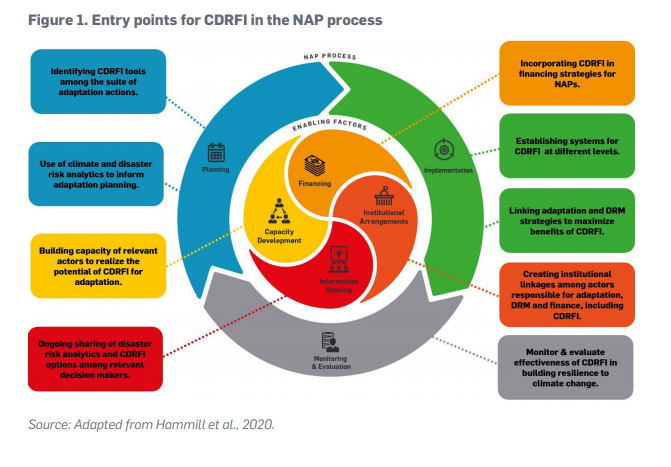Climate and disaster risk finance and insurance (CDRFI) solutions can play an essential role in climate change adaptation, enabling governments, businesses, and individuals to adequately plan for and react to climate-induced extremes and disasters.
The warning from the IPCC’s recent 6th assessment report made headlines as “sobering reading”. In the light of accelerating climate change, more frequent and intense extreme events, in May this year, G7 Ministers of Climate and the Environment had called on “all states and non-state actors to cooperate to to enhance adaptation and resilience, including through [the] InsuResilience Global Partnership, and National Adaptation Plans Global Network” (NAP GN). The result of a collaboration between InsuResilience and the NAP GN, a new report examines entry points for CDRFI to enhance national resilience-building efforts through NAPs.
The report presents an analysis of ways in which existing National Adaptation Plans and those under way have already integrated CDRFI, and suggests ways for both NAP and CDRFI actors to increasingly consider interlinkages in the future.
CDRFI tools and expertise can enhance NAP processes in a variety of manners (see figure 1). During the adaptation planning stage, risk analytics can inform the selection of adaptation options and priorities. In addition, selected CDRFI tools can be set up and applied at the implementation stage. When monitoring and evaluating progress of the NAP process, CDRFI-related metrics can contribute to a broader picture of adaptation ‘success’. Throughout the entire process, early inclusion of CDRFI considerations can also positively affect the way in which enabling factors facilitate NAP process.

Building on this conceptual framework, some striking findings emerge from the report’s analysis. For instance, 90% of countries with a National Adaptation Plan in place already plan to use insurance for resilience-building, in particular in the agricultural sectors. Non-insurance CDRFI tools specifically adept for lower risk-layers in a risk-layered approach, however, are underrepresented. Other themes relevant to CDRFI expertise and common across NAPs include adaptive social protection schemes, as well as the need for improved data generation, management, and analysis.
The report ends on a set of recommendations for NAP stakeholders in vulnerable countries, as well as for external support actors. Pulling in the same direction, more should be done to seize the potentials that CDRFI integration holds for building resilience through NAPs!
The report can be accessed here, with a French (version française) and Spanish (versión en español) short version available online.
The official report launch event will take place on September 1st. The event details and registration form can be found here.
